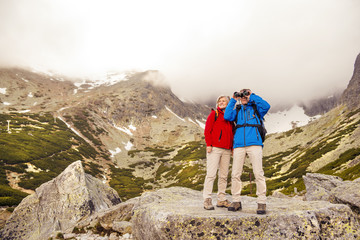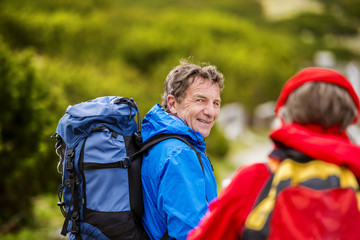Looking to find a fun new hobby that you can enjoy as an adult, that benefits your health, your weight, and boosts happiness levels? Three words – take a hike!
Benefits of Hiking
 Hiking outdoors offers loads of health benefits for both your body and mind. For adults especially, hiking is considered a go-to low-impact exercise activity that is easy on the joints but helps build muscle and maintain bone density too.
Hiking outdoors offers loads of health benefits for both your body and mind. For adults especially, hiking is considered a go-to low-impact exercise activity that is easy on the joints but helps build muscle and maintain bone density too.
Whether you’re trekking a mild to moderate path, or a longer, more inclined mountain trail, hiking is bound to get your heart rate up. Not only does this strengthen the heart muscle and cardiovascular system, but it helps lower your risk of developing heart disease, diabetes, or having a stroke or heart attack.
Keeping bone density in check is an important priority for older adults, significantly women. Low-impact physical activities like hiking help maintain strong bones, and when combined with calcium-rich diets, can reverse the signs of bone loss as well.
And did you know that walking in nature has actually been shown to help lower blood pressure and relieve feelings of stress and anxiety? Experts believe that spending time in nature without the hubbub of busy urban life around you can actually boost feelings of happiness and attentiveness as well as lower your desire to ruminate or brood over bad emotions.
How to Get Started Hiking
Want to give a new hiking hobby a successful start? Don’t miss these helpful tips and best practices:
Find well-fitting hiking shoes. Your worn out tennis shoes aren’t your best bet when it comes to hiking. Well-fitting hiking boots or hiking shoes support your movements, help stabilize the ankle on rough terrain, and give you cushioning against the forest floor.
Start with easier trails. You wouldn’t head for a Black Diamond if you were just starting skiing, the same goes for hiking. Find a more basic trail that matches your fitness level, and which is easy to access and navigate.
Familiarise yourself with terrain and trail terminology. Do you know what trail markers might look like? Or what a switchback on a trail is? Brush up on trail terminology and the terrain of your surrounding region before hitting the mountains.
Check the weather. Don’t let a sudden rainstorm spoil your big adventure. Be mindful of checking the weather prior to heading outside so you can prepare accordingly.
Pace yourself. Remember, most trails you’ll hike up and then return to your car or bike via the same path. Using up all your energy in that first hour will make the return trip more exhausting.
Don’t litter. It’s hiker code that you should always leave a trail as you found it – leave no trace of your hike. That means leaving natural odds and ends in place, picking up after yourself, and not moving trail markers.
What to Pack When Hiking
 While heading out solo with not a care in the world may seem like a freeing idea, when hiking, you want to be prepared and safe. Don’t forget these important items:
While heading out solo with not a care in the world may seem like a freeing idea, when hiking, you want to be prepared and safe. Don’t forget these important items:
Sunscreen. Even under the cover of tree canopy, the sun’s rays will find you so be smart about protecting your skin from UV radiation. Don’t forget sunglasses and hats for those ultra sunny days as well.
Water. Whether it’s a canteen, water bottle, or camelbak, having water on hand is a must to maintaining hydration when hiking.
Snacks. Depending on the length of your hike, you may want to pack small snacks like granola bars, crackers, dried fruit, protein bars, or other choice energy boosters.
Navigation. Chances are your mobile phone may not have reception or a connection deep into the woods so relying on it for a map isn’t safe. Paper maps and compasses are your best bet and good items to remember in your backpack.
Basic first aid items. While hiking isn’t necessarily ‘dangerous,’ tripping over a tree root or scraping your arm on a branch is feasible. Basic first aid items like band-aids, ankle or wrist wrap, chemical ice pack, etc. may be a good idea to include in your packing.
Walking stick. Hiking sticks and walking staffs may benefit older hikers who need extra support to keep up their stamina. If you suffer from arthritis or carpal tunnel syndrome, you may want to wear a thumb splint or carpal tunnel brace when using walking sticks to aid your grip.
Extra layers. Starting your morning hike off in cooler temperatures may have you sporting a sweater, but by the time the sun comes out and your heart rate is up, you’ll want to be able to strip down to a t-shirt or lighter clothing.
Flashlight. Don’t plan on hiking within hours of sunset without bringing a flashlight or headlamp. You’ll never know if you’ll need a little extra light to help you find your way.
Check out some of the best walking and hiking trails in New Zealand over on NewZealand.com and happy hiking!









Join the Discussion
Type out your comment here:
You must be logged in to post a comment.